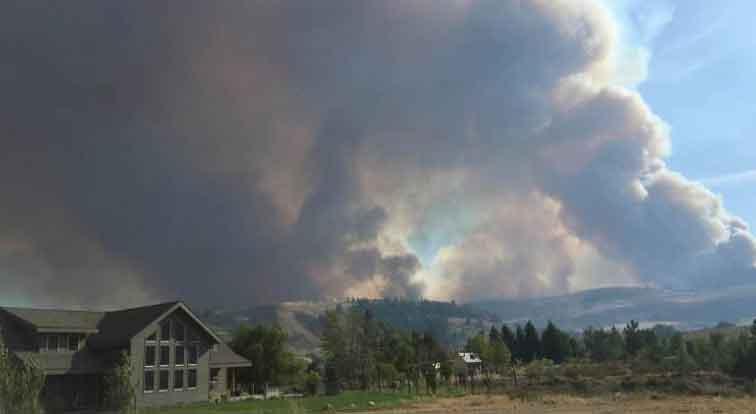
TWISP, Wash. — Three firefighters have died in a wildfire in north-central Washington, the state’s governor, Jay Inslee, said on his website Wednesday night.
Four firefighters were injured, according to the governor.
It happened near the town of Twisp, Okanogan County Sheriff Frank Rogers said.
The sheriff said the wind suddenly shifted and the firefighters became trapped as the Twisp River Fire was turned back on them.
“They gave their lives to protect others. It was their calling, but the loss for their families is immense, and I know the community will come together to support them,” Inslee said.
Residents in two small towns were evacuated as a wildfire quickly approached homes and other buildings.
Twisp and Winthrop each have fewer than 1,000 full-time residents.
“There are some outlying resort hotels being evacuated, too, and everyone is going to either Brewster or Omak because the Washington Pass is closed because of the fire,” said Eli Hamblet with the Okanogan County Department of Emergency Management.
More than a dozen California fires
A faulty gas water heater caused a wildfire that joined another blaze and together scorched more than 100 square miles in northern California this month, authorities said Wednesday.
The cause of the second fire remains under investigation, said the California Department of Forestry and Fire Protection, or Cal Fire.
The gas water heater was in an outbuilding that contained flammable liquids, and the fire then spread to nearby brush and the surrounding area, Cal Fire said.
Circumstances of how the failure of the heater started the fire are also still under investigation, authorities said.
The Rocky Fire burned almost 70,000 acres, or 109 square miles, in Lake, Yolo and Colusa Counties over 16 days until August 14.
The fire forced more 13,000 residents to evacuate and ultimately destroyed 43 homes and 53 outbuildings, authorities said. The fire started July 29 near the community of Lower Lake.
On Wednesday, more than 10,000 firefighters battled 16 wildfires in California, authorities said.
The biggest of those blazes, the River Complex Fire, was 20% contained after burning 45,477 acres in northwestern California, and the Trinity County Sheriff’s Department ordered the evacuation of the communities of Denny, Quinby, Dailey, Hoboken and Bell Flat, authorities said.
Lightning caused that fire, authorities said.
A record-setting drought has “turned much of the state into a tinderbox,” California Gov. Jerry Brown said during this month’s wildfires.
Meanwhile, all Oregon is in a severe or extreme drought, and the state on Wednesday banned all campfires, fire pits, tiki torches and candles in state parks and on ocean beaches, the Oregon Parks and Recreation Department announced.
The state park ban doesn’t apply to propane stoves or charcoal briquettes for cooking, except in cases where there are local restrictions, the state said.
“Our goal is to avoid any accidental fires on OPRD property that would further tax limited firefighting resources,” said MG Devereux, the department’s deputy director. “Most communities have sent local firefighters and equipment to help with wildfires throughout the state.”
Military help
Several other Western states also face a drought, though none to the exceptional level that California faces, the U.S. Drought Monitor said.
About 200 active duty military personnel will help fight the wildfires in seven Western states, the first time since 2006 that soldiers from Joint Base Lewis McChord, Washington, were deployed for such duty. The mobilization signals how strong the conflagrations have become.
At the same time, 1,000 National Guard members were helping fight wildfires that burned 750,000 acres — or 1,170 square miles — in Washington, Oregon, California, Idaho and Montana, officials said.
The guard members create firebreaks as hand crews, build floating bridges for firefighters, and also fly aircraft that drop water, officials said.
“We are able to provide surge capabilities that not only help the almost-depleted civilian air tankers, but hopefully provide other crews some reprieve,” Air Force Col. Scott Sanders, commander of the MAFFS Air Expeditionary Group, said in a statement.
Oregon Gov. Kate Brown said about 125 National Guard members from her state will begin firefighting training this week and are expected to join the fire line late next week.
“We have weeks of fire season left, and it is incumbent upon us to make sure that above all else, we continue to protect the public’s safety,” Brown said in a statement.